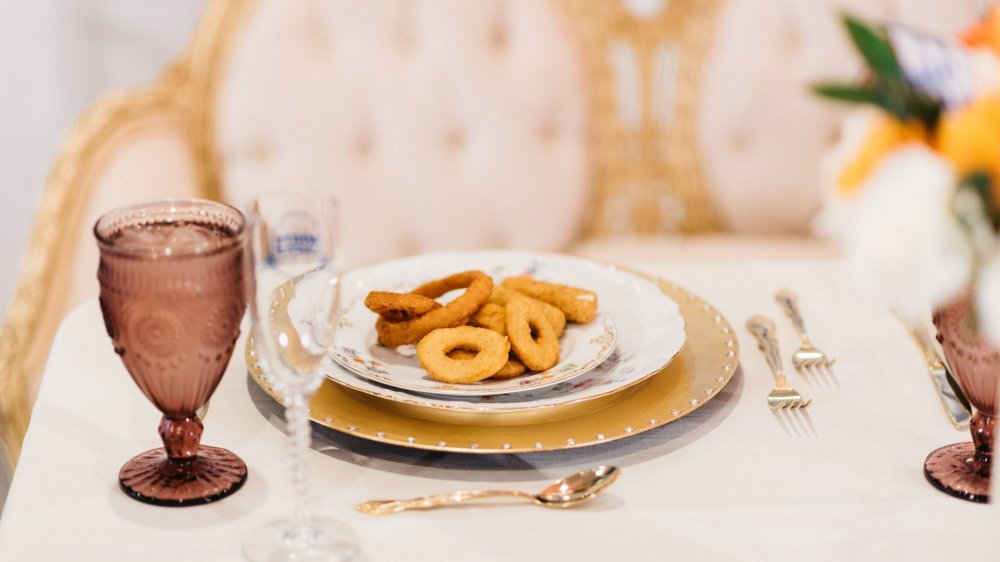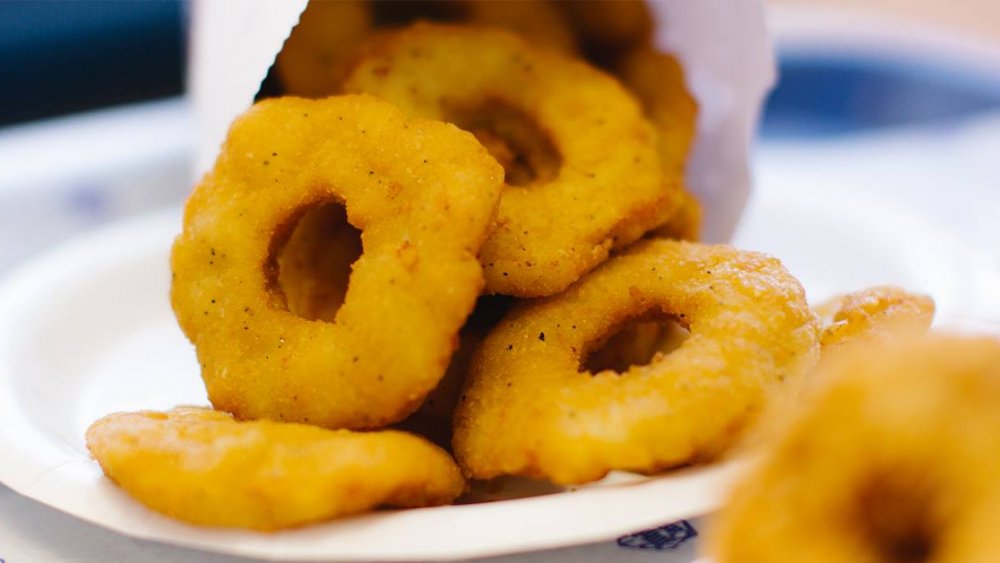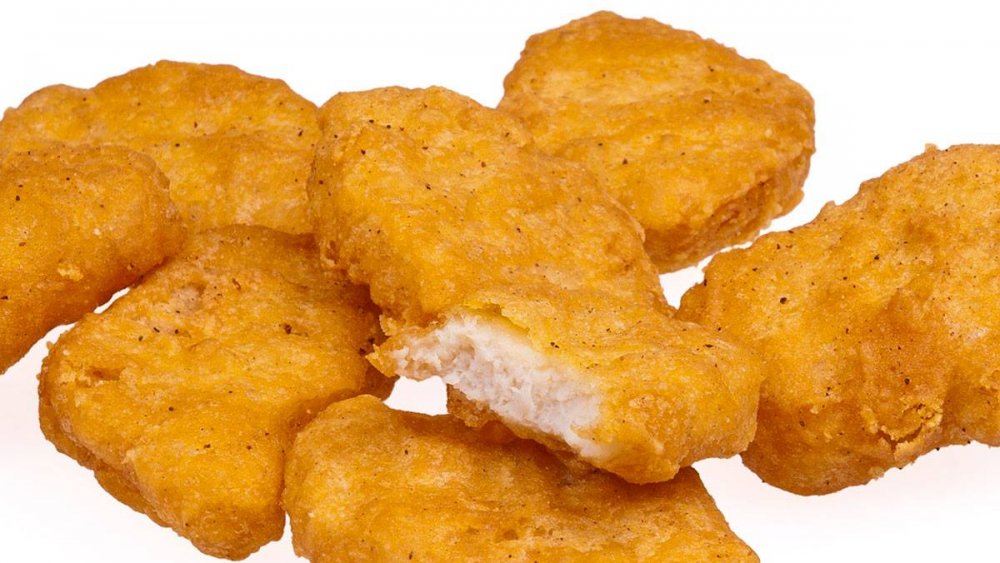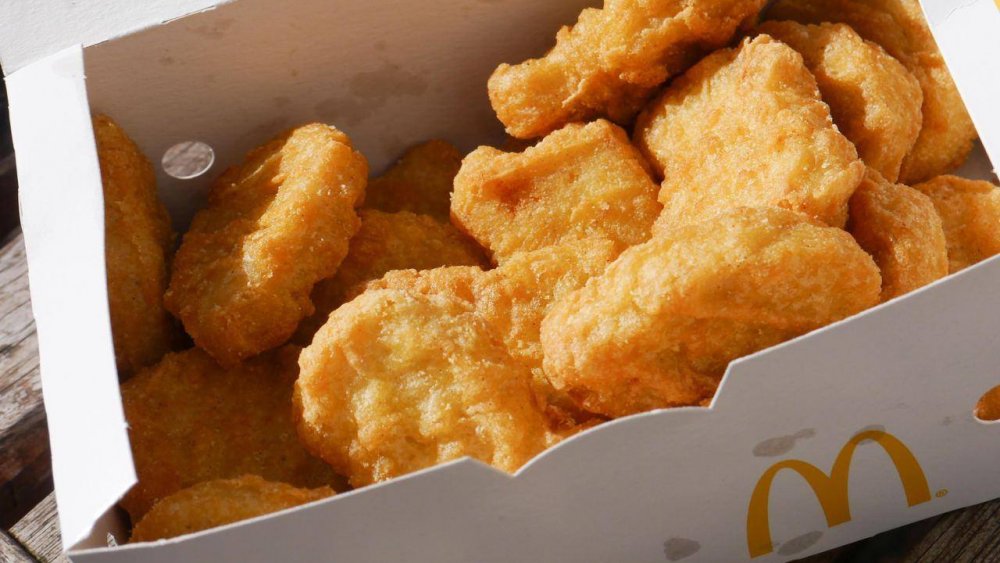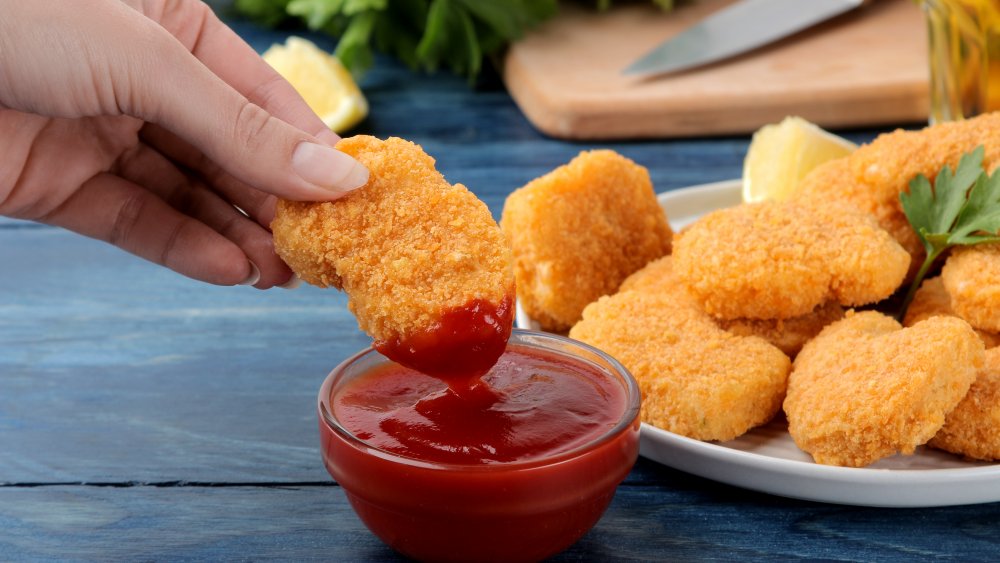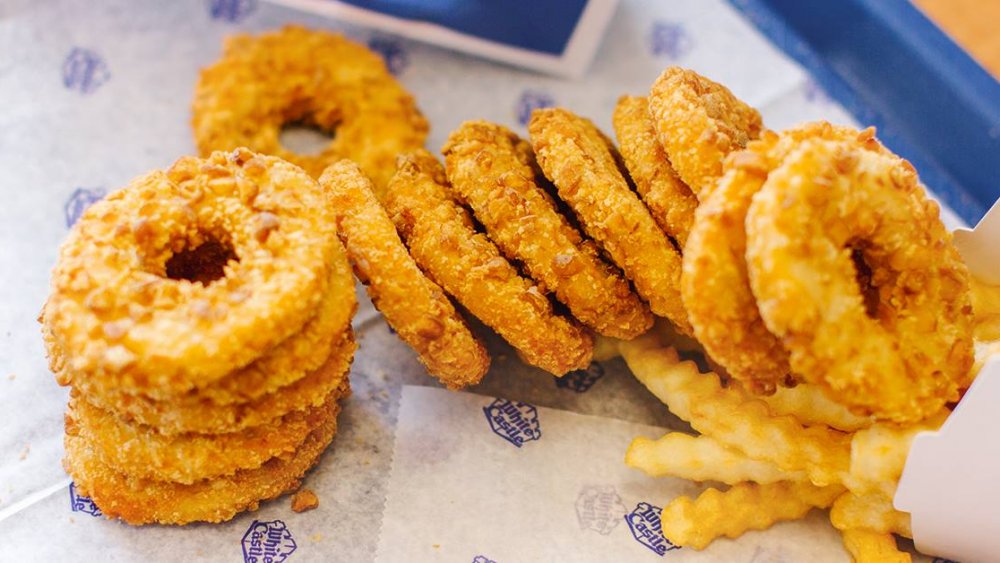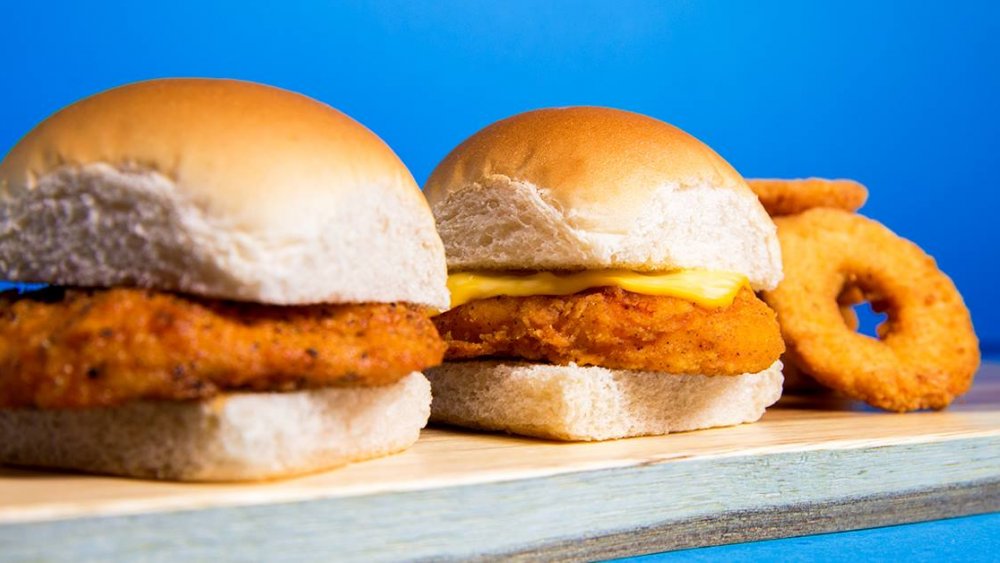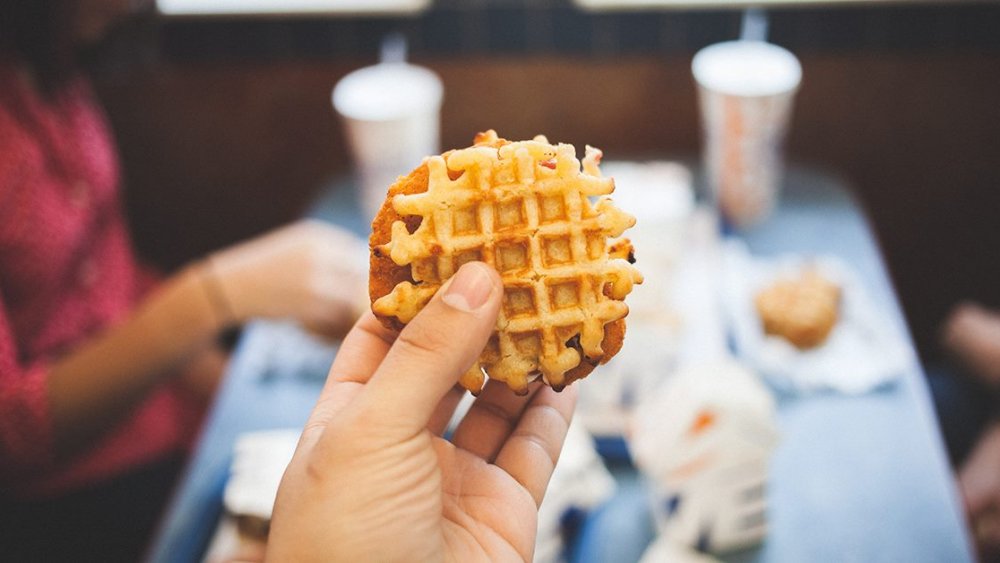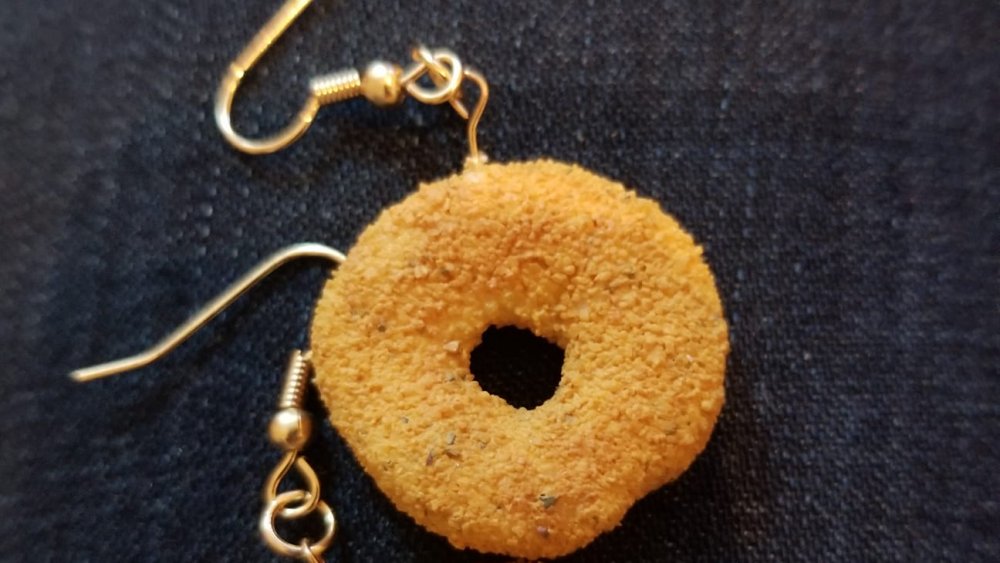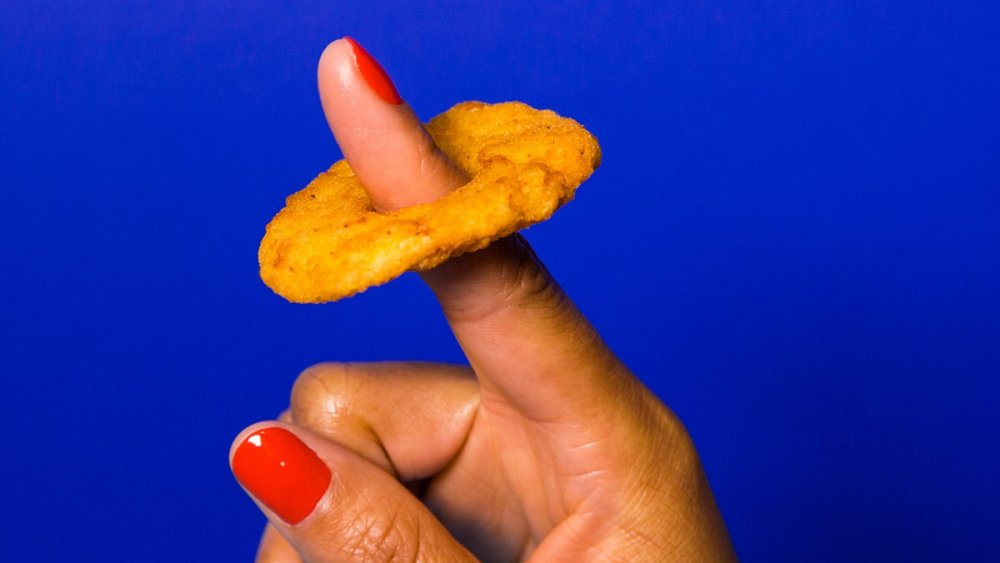What You Should Know About White Castle's Chicken Rings
In America's fast food nugget universe, White Castle's hole-y chicken rings stand apart from the pack. Compared to all the other amorphous chunks of chicken, the shapely White Castle chicken ring is a thing of wonder whose mysterious design is capable of inspiring an entire NPR discussion panel. Dissecting the ring, one participant confessed that while the optimist in him was convinced that the White Castle chicken ring was just a McNugget with "all the unhealthy stuff" poked out the middle, the pessimist in him realized that it was "one of the wheels on the ambulance that's taking us all to the hospital."
Tellingly, people's reactions to chicken rings often seem to cut both ways. "Unsettlingly tasty" but not so nutritious, they inspire adoration and revulsion (not to mention fashion), sometimes at the same time, as evidenced by Yelper Laura P., who confessed to having a "HIGHLY dysfunctional" love-hate relationship with them: "how can I break up with a chicken ring???"
And yet, in the almost 20 years they've been in existence, chicken rings have stealthily achieved the status of a unique and immediately recognizable fast food icon. Here's everything you need to know (and more) about the signature item most identified with White Castle after its legendary sliders (and they had an 81-year head start).
Chicken rings were born in 2002
Judging by the lack of Google-able information surrounding the invention of White Castle's chicken rings, you'd think that they were an immaculate conception. When Fast Food News writer asked the question, "What the heck is a chicken ring?" he lamented the absence of a dedicated chicken ring website with a bonafide backstory as to its origins. Instead, White Castle produced a viral video based on a "long-standing urban myth" of a strong, spicy-scented poultry farm in which a bunch of "O" shaped chickens ran around with gaping, donut-like holes in their middles.
In reality, what is known about these iconic rings — which consist of 100-percent white chicken meat that's battered, breaded, and then deep fried to a crisp — is that they were initially launched by White Castle in 2002. Although they exist in the form of a slider (between two buns), they've been most popular as a side. Available in three, six, nine, and 20-piece servings, their high dunkability rating explains why they're obligatorily accompanied by a variety of dipping sauces.
But the chicken ring concept dates back to 1963
While the specific origin of the chicken ring remains shrouded in myth, in terms of its genesis as a "species," it can be traced back to the early 1960s and Robert C. Baker. A professor of poultry science at Cornell University, Baker has been described as "the Godfather of chicken rings."
During World War II, U.S. chicken production increased enormously, driven by the need to feed troops. However, after the War, demand plunged. At the time, most chickens were sold by butchers and consumed whole — preparing them was time-consuming and messy. To survive, the poultry industry had to make chicken more desirable. Enter Baker, who set up a poultry products technology lab at Cornell. Here, he created dozens of edible items made from "further processed" poultry, i.e., ground-up chicken made to look like something else, including hot dogs, meatballs, and cold cuts.
Slate describes how Baker and a grad student devised a prototype for chicken rings: a frozen, breaded "chicken stick." This pioneering poultry product was a feat of two food engineering challenges: keeping ground chicken meat together without a surrounding skin and keeping the batter attached to the meat despite shrinkage caused by freezing and the explosive heat of frying. It also revolutionized the way Americans eat chicken. According to Fast Food and Junk Food, up until 1980, most chickens were sold whole. By 2010, 90 percent were sold in pieces used to make cutlets, nuggets — and rings.
Why chicken rings?
Despite Baker's invention of "chicken sticks," hamburgers (and sliders) continued to rule the fast food roost until the late 1970s. In 1977, the U.S. government released its first-ever dietary guidelines, which warned Americans to dial down their consumption of fat and especially red meat. As a consequence, consumers panicked, and burger sales plummeted.
Fast food chains frantically searched for a less threatening alternative and landed on protein-rich chicken. As Time reports, at the forefront of the search was McDonald's who went so far as to hire Queen Elizabeth's former chef to contribute ideas such as chicken pot pie (which bombed). Eventually, McDonald's scored enormously with McNuggets. Available nationwide in 1983, they quickly became a global phenomenon.
Burger rivals quickly lept onto the nugget bandwagon. Burger King released its own version in 1985, and Wendy's followed with crispy chicken nuggets in 1986. As for White Castle, according to The New York Times, as it sought to modernize and attract younger customers, the fast food pioneer was also attempting to shake off its connection to the sliders known as "gut busters" and "belly bombers." In 1988, it was test marketing its own version of nuggets. Mysteriously, it took another 14 years before chicken rings hit the market — an impressively long incubation period. Yet despite the presence of 100 percent white meat, you can easily bust a gut. Chicken rings' high levels of fat, sodium, and carbs make them decidedly unsuitable from a nutritional standpoint.
Chicken rings vs. nuggets is a major chicken rivalry
Interestingly, even though chicken rings and chicken nuggets share a common ancestry and product DNA, White Castle has played up the rivalry between its signature rings "with their great taste and fun shape" and its competitors' "boring, old," nuggets. Recently, the slider king added fuel to the feud when it released the results of a nationwide survey of White Castle email subscribers conducted in June 2020.
According to the survey's findings, 87 percent of the "hundreds of" respondents copped to preferring White Castle chicken rings over their "amorphous chicken counterpart." They claimed they were tastier (86 percent), more "craveable"(87 percent), and even more shareable than nuggets.
Yet, although "Craver Nation" (as loyal subjects of the White Castle realm are known) may be devoutly Team Chicken Ring, the general populace is less enthusiastic. On Ranker, chicken rings recently ranked 25th out of 28 edible White Castle items (although the chicken ring slider came in seventh). Food sites also tend to toss White Castle's rings to the lower depths of its fast food nugget rankings. While citing their plumpness and dip-ability (albeit due to a lack of flavor), Eater ranked them sixth out of nine candidates. Even less impressed, Mashed and Fast Food were united in ranking the rings last (out of eight and 20, respectively), citing blandness and/or just plain bizarreness.
Flavored and pretzel chicken rings have been a thing
Perhaps attuned to the aforementioned charges of blandness, White Castle has made numerous attempts to pump up the flavor of its chicken rings. Over the years, the fast food chain has rolled out limited-time flavor offerings that include Buffalo, Hidden Valley Ranch, and Tabasco (the latter two, in partnerships with those respective brands). Not to be confused with dipping sauces — which have included BBQ, honey mustard, ranch, nacho cheese, and zesty zing — the flavoring in these chicken rings allegedly comes from flavor powder, which is poured into the bag containing the freshly fried rings and shaken up. Reactions to the Hidden Valley Ranch flavor on Fast Food News ranged from "great" to "too little powder" to "tasted fine ... made me sick for two days."
In an effort to mix up not just the traditional chicken ring flavor but its texture as well, in 2016, White Castle decided to get in on what Brand Eating dubbed the "pretzel trend." Another limited-time experiment, White Castle's pretzel chicken rings were — as The Impulsive Buy delightedly noted — actually breaded with crunchy little chunks of pretzel (minus the sprinkling of rock salt). Eater referred to them as a hybrid of three completely unrelated foods, which tasted neither like chicken nor pretzels and were meaninglessly donut-shaped. Although the pretzelly crunchiness earned praise, Eater's reviewer decried the lack of a pretzel's essential "maltiness and saltiness," which made the limited-time-only treat "uniquely awful."
Chicken ring sliders are the best and worst
It might seem like a culinary contradiction to think that scarfing down a White Castle chicken ring slider can be both good and bad for you. However, in a nutritional breakdown commissioned by Eat This, Not That!, registered dietician Staci Gulbin managed to make a convincing case.
First, the good news: Gulbin deems the chicken ring slider with cheese as one of the "best" of White Castle's meal options. Despite the not-so-reassuring presence of two breaded chicken rings, Gulbin counters that the moderate levels of calories, fat, and sodium in the sandwich make it a "decent" choice.
However, things get worse, fast, when it comes to the crispy chicken ring slider with cheese. Who would have thought that a single word — "crispy" — could do so much damage? However, it does so by radically upping the levels of sodium from 470 mg to 620 mg (the American Heart Association's ideal limit is 1,500 mg for an entire day). Moral of the menu: If you're in a nutritious state of mind, avoid the "crispy."
Hack the menu with chicken rings
Like all fast food joints worth their salt, White Castle has a secret menu, one of whose favorite hacks just happens to showcase the chicken ring slider. It's called a cowboy slider and involves ordering a chicken ring slider along with a side of onion rings and BBQ sauce. First, the top bun needs to (temporarily) come off the slider. Become Lord (or Lady) of the Rings by piling crispy onion rings on top of the crispy chicken rings. Then turn up the heat by dousing all those rings with sauce before placing the bun back on top and taking a big Texas-sized bite out of that cowboy.
Another favorite breakfast-centric hack (which can be enjoyed all day due to White Castle's all-day breakfast policy) pairs an order of chicken rings with an order of mini Belgian waffles, which come with an essential side serving of syrup. Simply arrange the rings between the two waffles, sandwich-style, pour on the syrup, and then let your day begin (regardless of the hour). Incidentally, when Thrillist originally dreamed up this hack in 2015, in the days before White Castle waffles even existed, it was created with (the lamentably discontinued) French toast sticks in mind.
White Castle gave away a $5,000 diamond 'chicken' rings
Faced with a constant tide of criticism questioning the mere existence of a chicken nugget shaped to resemble a ring, White Castle has steadfastly defended its trademark poultry treat by defiantly playing up its similarities to actual bling. In 2019, White Castle went so far as to team up with Dr. Pepper to create a Ring Thing Giveaway. White Castle customers who ordered a portion of chicken rings along with any sized soft drink were automatically entered into sweepstakes with prizes that included 400 coupons for sliders and 100 pairs of chicken ring earrings.
The grandest prize of all, however, was a "halo-style" diamond ring worth $5,000, whose key design feature — a hollow center — was a dead ringer for White Castle's crispy chicken treat. That the design of the ring gave out "Let's Get Engaged" vibes wasn't lost on the fast food company, whose executives take pride in the fact that its flesh-and-bone(less) chicken rings have played a central role in many marriage proposals that have taken place at White Castle.
"It's not uncommon to have great memories made, whether it's wedding proposals or actual weddings," Jamie Richardson, vice president of the family-owned company confessed to Restaurant Business, adding, "They can always use Chicken Rings."
Some couples serve — and exchange — chicken rings at their weddings
Jamie Richardson has been with White Castle since 1999 and, according to The Ringer, he's a sucker for love in a fast food setting. As detailed in The Atlantic, White Castle is actually the scene for a lot of "royal" weddings (75 and counting), many of which take place on Valentine's Day. This isn't just because many couples love sliders and chicken rings or because White Castle offers a pretty cheap venue. It's also due to the fact that the chain actively seeks out engaged couples, going so far as enlisting local radio stations to track down candidates.
Seemingly, no White Castle wedding is complete without the symbolic (albeit edible) rings. They were prominent at Mariana and Jasmine's 2015 Bronx wedding as well as at a 2012 Indianapolis wedding where guests could choose between ranch chicken rings and jalapeno cheese sliders.
Then there was Adam, who grew up in Queens, where he developed a "deeply engrained love" for White Castle. Before tying the knot with the other love of his life, Whitney, Adam took his fiancée to White Castle for the first time where, as he told Brides, "she immediately fell for the Chicken Rings." Happily, she still had enough love left over to tie the knot with Adam (amid towers of chicken rings) at a White Castle destination wedding in Las Vegas.
50,000 fans tuned into a Facebook Live White Castle chicken rings event
One of the more original fast food promotions in recent years took place in 2018 when White Castle staged what Ad Age described as an "impressively authentic" home shopping event on Facebook Live. Riffing on QVC-style jewelry pitches, the White Castle stunt featured Heather and Janelle, played by two improv actresses with seriously flip-able hair. While trading lots of eye rolls and juicy ring puns, they spent some 45 minutes hilariously hyping and hawking White Castle chicken rings (12 for $2.99!) along with a quartet of dipping sauces.
Along the way, there were supporting cameos from Sarah the chicken ring model, Doug the ring appraiser, and Dylan, the ideal boyfriend, who excitedly confessed he was about to propose marriage to his girlfriend at White Castle with — what else? — a chicken ring.
Heather and Janelle also responded in real-time to comments from some of the more than 50,000 viewers who tuned in to watch the live stream. On YouTube, where a condensed 30-second version of the mock advertisement was posted and received over 2.3 million views, commenter Jame Mayweather called it the "best commercial ever."
Chicken rings are the ultimate fashion muse
Who would have guessed that a ring-shaped, deep-fried chicken nugget made by an Ohio-based burger joint would become the muse of one of New York City's most avant-garde fashion designers? However, if the ring fits ...
Considered one of America's most important young designers (and winner of multiple CFDA Awards), Telfar Clemens grew up eating at White Castle in his native Queens. The experience nourished him to the extent that he not only redesigned some 12,000 new and genderless uniforms for employees at 400 locations, but he also features White Castle-inspired garb in his own collections. There was also the time he single-handedly revived New York Fashion Week's after-party scene by holding what ID described as an "astounding, exceptional, and endlessly inspiring party" at a White Castle in Times Square. Aside from DJ Michael Magnan booming tunes behind the counter, staff was circulating with sliders and chicken rings. More recently, in 2019, the beloved rings turned up again at the actual show.
In fact, as ID observes, the synergy between Telfar and White Castle is best expressed by White Castle's most "awkward" menu item. Other conventional chicken nuggets try to disguise their "further processed" origins. However, the unapologetic chicken ring makes no such pretense, becoming an apt symbol for Telfar's own no-nonsense but celebratory vision of everyday America.
Get ready for robot-fried chicken rings
It turns out that, contrary to common perception, White Castle is not only fashion-forward, but in the tech vanguard. In 2020, the fast food chain marked its 99th year in business by announcing a partnership with Miso Robotics, creator of Flippy the Robot.
The most recent Flippy model is suspended overhead on a rail, from which it can slide back and forth. At White Castle, Flippy will be manning (robot-ing?) several frying stations. If everything goes according to plan, it will soon be responsible for the timely hotness and crispy-ness of your chicken rings.
Although White Castle's negotiations with Miso began in 2019, COVID-19 has made robots even more attractive in a context in which restaurants are restructuring in order to minimize contact between human employees as well as between human employees and food. Moreover, robots can tackle kitchen tasks — such as deep frying — that can be both dangerous and tiring, not to mention boringly repetitive. In a July 2020 interview with The Spoon, White Castle Vice President Jamie Richardson announced that Flippy would be starting work soon at an undisclosed Chicago location. "A new hire like Flippy frees us up to have team members do other things like delivery," which has become more important during pandemic times. It remains to be seen if the new robot-fried chicken rings will taste differently than the human-fried original version.
